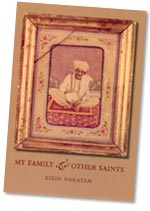Family, memories at core of anthropologist’s new book
Kirin Narayan first decided to write a book about her family when she was 10 years old, a decision she made while growing up in Bombay, the child of an American mother and an Indian father.
“Growing up in a household with multiple cultures made me very aware that what some people view as normal can seem quite strange to others. I also became aware of the power of storytelling as a way for people to make sense of their lives.”
Kirin Narayan, professor of anthropology
It was 1970, the year after her 16-year-old brother announced he was quitting school and leaving home to go live with a guru. The family’s beachfront home had already become a well-known haven for hippies and visitors from the West looking for enlightenment, part of the wave of seekers obsessed with yoga, meditation and finding gurus that swept over India at that time.
Her parents represented conflicting ideologies, but not in the way readers would expect. Narayan’s mother, "Maw," fully adopted Indian dress, customs and attitudes, while her father, "Paw," was skeptical of anything to do with mysticism or religion.
"I did have some sense of living in an unusual story, even then. I was also an intrigued transcriber of events. I used to staple together a postage stamp-sized magazine called ‘The Family’ and would sometimes write up special issues," says Narayan, an anthropology professor at the University of Wisconsin–Madison. "In college I wrote short stories about my family. It was always in the back of my head that at some point I would write a book about growing up in this cross cultural household in India, and the kinds of guests and adventures we encountered together."

In My Family and Other Saints, anthropology professor Kirin Narayan tells her story of growing up in Bombay in the late 1960s.
Narayan trained in cultural anthropology and folklore and has spent years studying South Asian folklore, including the stories told by holy men from her childhood. But it wasn’t until she entered her 40s and her father died that she felt the time was right to tell her own story.
Without a doubt, Narayan says her childhood was absolutely critical in forging her career as an anthropologist.
"Growing up in a household with multiple cultures made me very aware that what some people view as normal can seem quite strange to others. I also became aware of the power of storytelling as a way for people to make sense of their lives," she says.
Library Journal says Narayan’s memoir, My Family and Other Saints (University of Chicago Press, 2007), is "informed by her professional anthropologist’s view: she brings the food, clothing and colors of the unique period in the late 1960s to life," and its review calls the book "a revealingly honest, humorous and loving portrayal of unique times."
Narayan interviewed some of the young seekers who had stayed with the family — to get their perspectives — many of whom are now "middle-aged people in successful careers." But she also drew heavily from her own memory, conversations with family members, journals written by her older brother, and scraps of writing and piles of letters she kept from childhood.
"I’m a great keeper of memorabilia. My Maw calls me the family archivist, so all that came to good use," she says.
She also received extensive input from her mother, who now resides in the foothills of the Himalayas and provided comments on every chapter, writing about the finished book that "the feeling is hard to describe — the character of one’s own self seems both strange and familiar."

